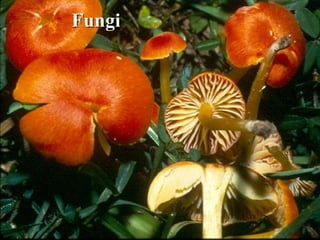
FUNGI FULL NEW.pdf
- 1. Fungi
- 2. Characteristics of fungi Diverse group of chemo heterotrophs Over 100,000 fungal species identified Only about 100 are human or animal pathogens Saprophytes – Digest dead organic matter Parasites –Obtain nutrients from tissues of organisms Most are aerobes or facultative anaerobes
- 3. The Characteristics of Fungi • Heterotrophy - 'other food' * Saprophytes or saprobes - feed on dead tissues or organic waste (decomposers) * Symbionts - mutually beneficial relationship between a fungus and another organism * Parasites - feeding on living tissue of a host. • Parasites that cause disease are called pathogens.
- 4. Morphology of fungi • Fungi are eukaryotic protista; differ from bacteria and other prokaryotes. 1. Cell walls containing chitin (rigidity & support), mannan & other polysaccharides 2. Cytoplasmic membrane contains ergosterols 3. Possess true nuclei with nuclear membrane & paired chromosomes 4. Cytoplasmic contents include mitochondria and endoplasmic reticulum 5. Divide asexually, sexually or by both 6. Unicellular or multicellular 7. Most fungi are obligate or facultative aerobes
- 6. Morphology of fungi • Body form * unicellular * filamentous (tube-like strands called hypha (singular) or hyphae (plural) * mycelium = aggregate of hyphae * sclerotium = hardened mass of mycelium that generally serves as an overwintering stage. * multicellular, such as mycelial cords, rhizomorphs, and fruit bodies (mushrooms)
- 8. Hyphae • Elongation of apical cell produces a tubular, thread like structure called hypha. • Hyphae may be septate or nonseptate. • Hard wall of chitin • Crosswalls may form compartments (± cells) • Multinucleate • Grow at tips
- 9. Hyphal growth • Hyphae grow from their tips • Mycelium = extensive, feeding web of hyphae • Mycelia are the ecologically active bodies of fungi This wall is rigid Only the tip wall is plastic and stretches
- 11. Mycelium • Mass of branching intertwined hyphae a. Vegetative Mycelium- hyphae that penetrate the supporting medium and absorb nutrients b. Aerial Mycelium- hyphae projects above the surface of medium and bear the reproductive structure called conidia.
- 12. Classification of fungi 1.Morphological classification 2.Systematic classification
- 13. Morphological classification 1. Yeasts 2. Yeast-like fungi 3. Filamentous fungi (molds) 4. Dimorphic fungi
- 14. Yeasts • These occur in the form of round or oval bodies which reproduce by an asexual process called budding in which the cell develops a protuberance which enlarges and eventually separates from the parent cell. • Yeasts colonies resemble bacterial colonies in appearance and in consistency • Examples are- Saccharomyces cerevisiae, Cryptococcus neoformans
- 17. Yeast-Like • Yeast like fungi grow partly as yeast and partly as elongated cells resembling hyphae. The latter form a pseudomycelium. Example: Candida albicans
- 18. Molds or Filamentous Fungi • The basic morphological elements of filamentous fungi are long branching filaments or hyphae, which intertwine to produce a mass of filaments or mycelium • Colonies are strongly adherent to the medium and unlike most bacterial colonies cannot be emulsified in water • The surface of these colonies may be velvety, powdery, or may show a cottony aerial mycelium. • Reproduce by the formation of different types of spores • Example: Dermatophytes, Aspergillus, Penicillium, Mucor, Rhizopus
- 20. Dimorphic Fungi • These are fungi which exhibit a yeast form in the host tissue and in vitro at 370C on enriched media and mycelial form in vitro at 250C • Examples: • Histoplasma capsulatum • Blastomyces dermatitidis • Coccidioides immitis • Paracoccidoides brasiliesis • Penicillium marneffei • Sporothrix schenckii
- 21. Histoplasma capsulatum - Dimorphism • Filamentous mold in environment -Thin septate hyphae, microconidia, and tuberculate macroconidia (8-14 µm) • Budding yeast (2-4 µm) in tissue -Dimorphic transition is thermally dependent and reversible (25°C 37°C).
- 22. Systematic classification • Based on sexual spores formation: 4 classes 1. Zygomycetes 2. Ascomycetes reproduce sexually 3. Basidiomycetes 4. Deuteromycetes (fungi imperfectii)
- 23. Zygomycetes • Lower fungi • Broad, nonseptate hyphae • Asexual spores Sporangiospores: present within a swollen sac- like structure called Sporangium Examples: Rhizopus, Absidia, Mucor
- 24. Ascomycetes • Sexual spores called ascospores are present within a sac like structure called Ascus. • Each ascus has 4 to 8 ascospores • Includes both yeasts and filamentous fungi
- 25. Ascomycetes • Narrow, septate hyphae • Asexual spores are called conidia borne on conidiophore • Examples: Penicillium, Aspergillus
- 26. Basidiomycetes • Sexual fusion results in the formation of a club shaped organ called base or basidium which bearspores called basidiospores • Examples: Cryptococcus neoformans, mushrooms
- 27. Deuteromycetes or Fungi imperfectii • Group of fungi whose sexual phases are not identified • Grow as molds as well as yeasts • Most fungi of medical importance belong to this class • Examples: Coccidioides immitis, Paracoccidioides brasiliensis, Candida albicans
- 28. Reproduction and sporulation • Types of fungal spores 1.Sexual spores 2.Asexual spores
- 29. Sexualspores • Sexual spore is formed by fusion of cells and meiosis as in all forms of higher life • Ascospores – Ascus – Ascocarp • Basidiospores • Zygospores
- 30. Asexual spores These spores are produced by mitosis 1.Vegetative spores 2.Aerial spores
- 31. Vegetative spores • Blastospores: These are formed by budding from parent cell, as in yeasts • Arthrospores – formed by segmentation & condensation of hyphae • Chlamydospores – thick walled resting spores developed by rounding up and
- 32. Aerial spores 1. Conidiospores Spores borne externally on sides or tips of hyphae are called conidiospores or simply conidia 2. Microconidia- conidia are small and single 3. Macroconidia- conidia are large 4. Sporangiospores- spores forms Within the sporangiophores.
- 33. • Microconidia - Small, single celled • Macroconidia – Large and septate and are often multicellular
- 34. Pictures of fungi on LPCBmount Aspergillus Penicillium
- 36. THANK YOU
